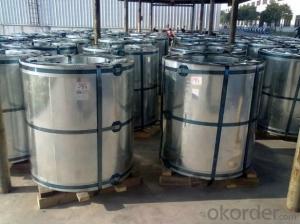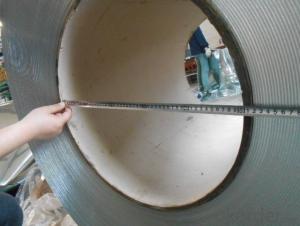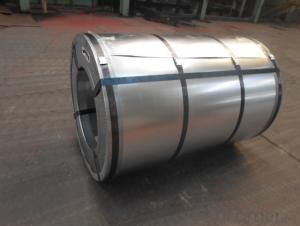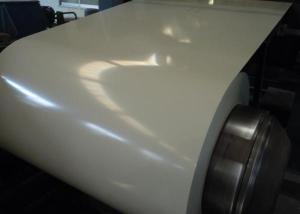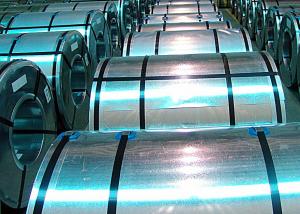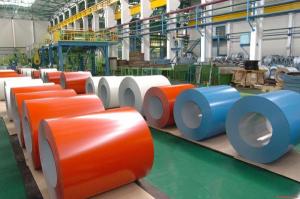Best Quality Galvanized Steel Coil
- Loading Port:
- China Main Port
- Payment Terms:
- TT OR LC
- Min Order Qty:
- -
- Supply Capability:
- -
OKorder Service Pledge
OKorder Financial Service
You Might Also Like
product information:
1)Operate Standard: ASTM A653M-04/JIS G3302/DIN EN10143/GBT 2518-2008
2)Grade : SGCD,SGCH, Q195,DX51D
3)Galvanized steel sheet /coil features:
4)Zinc coating :40-180g( as required)
5)width:914-1250mm(914mm, 1215mm,1250mm,1000mm the most common)
6)coil id:508mm/610mm
7)coil weight: 4-10 MT(as required)
8)surface: regular/mini/zero spangle, chromated, skin pass, dry etc.
9)application: Structural use ,roofing, commercial use, household appliance, industry, family;
special application: Wear resistant steel, high- strength - steel plate
Technical data :
Chemical Composition | ||||||
GRADE | C | Si | Mn | P | S | Ti |
SGCC/DX51D+Z | ≤0.10 | ≤0.50 | ≤0.60 | ≤0.10 | ≤0.030 | ≤0.020 |
DX52D+Z | ≤0.10 | ≤0.50 | ≤0.60 | ≤0.10 | ≤0.030 | ≤0.020 |
SGCD/DX53D+Z | ≤0.10 | ≤0.30 | ≤0.50 | ≤0.05 | ≤0.030 | ≤0.020 |
SGCE/DX54D+Z | ≤0.10 | ≤0.30 | ≤0.30 | ≤0.03 | ≤0.020 | ≤0.020 |
DX56D+Z | ≤0.10 | ≤0.30 | ≤0.30 | ≤0.03 | ≤0.020 | ≤0.020 |
Structural | ≤0.20 | ≤0.60 | ≤1.70 | ≤0.10 | ≤0.045 | |
hot dipped galvanized steel coil Mechanical Properties | |||
GRADE | Yield Strength MPa | Tensile Strength MPa | Elongation % |
SGCC(DX51D+Z) | ≥205 | ≥270 | - |
SGCD(DX53D+Z) | - | ≥270 | 38 |
SGCE(DX54D+Z) | - | ≥270 | 40 |
DX56D+Z | - | ≥270 | 42 |
- Q: i have purchased a high dollar Martin guitar and i was wondering if there are many people out there that have used steel string acoustics for classical and flamenco guitar playing.otherwise i will need a nylon stringeror.. uld i put nylon strings on an old yamaha steel string guitar that i have?
- If the guitar was designed for nylon strings, then don't put steel strings on it!
- Q: How many pounds can steel lift?
- much too vague. Need the shape and thickness of the steel, where it is supported, and where the load is placed.
- Q: how is stainless steel made? what are the things used in making it?
- There are 3 basic stainless steels. The Martinsitic, the ferritic, and the Austinistic. The spelling may be wrong on all of them. (Got out of school in 1966 with my metallurgy in 1965. The Ferritic is magnetic and has some resistance to corrosion but the Martinsitic is much more resistant to corrosion. The Austinitic stainless is very resistant to corrosion. The differences are the amount of Chrome and Nickel in the batches. The Austinitic has an 18/8 ratio of Chromium and Nickel with the rest Iron and minor ingredients. The carbon content is very important and these steels are often made in small batches with close monitoring of composition and carbon content. Scrap metals are frequently used with the chrome and nickel being added as carefully selected scrap or even fresh crude stocks. Electric melting is frequent to avoid contamination.
- Q: What are the properties of high-strength steel coils?
- High-strength steel coils possess several distinct properties that make them highly desirable in various industrial applications. Firstly, these coils exhibit exceptional strength, meaning they have a high tensile strength and can withstand significant amounts of force or weight without deformation or breakage. This property allows them to be used in demanding environments or for heavy-duty purposes. Another key property of high-strength steel coils is their excellent resistance to wear and tear. They have a high level of hardness, which enables them to resist abrasion, impact, and other forms of mechanical stress. This makes them ideal for applications where durability and longevity are crucial, such as in construction, automotive manufacturing, and machinery production. Additionally, high-strength steel coils often possess excellent corrosion resistance. They are typically coated or treated with protective materials to prevent rust or other forms of deterioration caused by exposure to moisture, chemicals, or harsh environmental conditions. This corrosion resistance property ensures the longevity and reliability of the coils, making them suitable for applications in marine environments or outdoor structures. High-strength steel coils also offer good formability, meaning they can be easily shaped or bent without losing their strength or integrity. This property allows manufacturers to create complex or custom shapes for specific applications, enhancing their versatility and adaptability. Lastly, high-strength steel coils are known for their light weight compared to other materials with similar strength properties. This low weight-to-strength ratio makes them a preferred choice in industries where weight reduction is crucial, such as aerospace or automotive manufacturing. It allows for improved fuel efficiency, increased payload capacity, and overall cost savings. In summary, high-strength steel coils exhibit properties such as exceptional strength, resistance to wear and tear, corrosion resistance, formability, and light weight, which make them valuable and versatile materials in various industries.
- Q: I was wondering what material most common motorcycle gas tanks are made out of? is it steel? stainless steel? aluminum? what are the advantages and disadvantages or each?
- Steel is most common. Aluminum is lighter but it's harder to form, so more expensive. Plus it dents more easily. And you can't use a magnetic tank bag. I've seen stainless steel tanks but they were usually specially made.
- Q: If steel can rust with saltwater... then why are ships made of steel? can't we just use other metals like aluminium etc?
- Steel became the medium of construction almost be accident. The Royal Navy began to coat its wooden ships with a coating of steel to give them added protection in battle. They were known as the Iron Clads. From this it was a small step by such people as Brunnel to start construction in iron, then various other steels. The Great Eastern is a classic example. Over the last one hundred years the main improvement is in welding rather than a riveted construction. Improvements in steel have lead to a reduction in the scantlings and through this a reduction I the weight of the ship which has allowed for an increase in the carrying capacity. There always have been specialist ships built with alternative materials. Aluminium, wood, concrete and GRP. GRP. Also it must be remembered that there has been great advances in steel, from the early days of cast iron.
- Q: Please explain why steel is denser than wood.
- The atoms in steel are more tightly packed. They have a greater mass in a smaller volume than wood. Basically, if you take 100 g of steel and 100 g of wood, the piece of steel will be smaller (less volume) than wood and therefore more dense. Density = Mass/Volume
- Q: How is the demand for steel coils influenced by the construction sector?
- The demand for steel coils is heavily influenced by the construction sector. As construction activities increase, so does the demand for steel coils as they are essential for various construction applications such as structural components, roofing, and reinforcing materials. Conversely, when construction activities decline, the demand for steel coils also decreases. Therefore, the construction sector plays a crucial role in driving the demand for steel coils.
- Q: What are the common methods of transporting steel coils?
- There are several common methods of transporting steel coils, depending on the distance, quantity, and specific requirements of the shipment. The most commonly used methods include: 1. Flatbed trucks: This is the most basic and widely used method for short-distance transportation of steel coils. Flatbed trucks have a flat, open trailer bed that allows for easy loading and unloading of the coils. The coils are secured and strapped down to prevent movement during transit. 2. Rail transport: For longer distances, rail transport is often preferred due to its cost-effectiveness and efficiency. Coils are loaded onto specially designed railcars, known as coil cars or gondola cars, which have curved troughs or cradles to hold the coils securely in place. This method is particularly advantageous for large quantities of steel coils. 3. Ocean freight: When transporting steel coils internationally or over long distances across oceans, shipping by sea is a common method. The coils are typically loaded into specialized shipping containers, known as coil containers or coiled steel containers, which have internal cradles to prevent movement and damage during transit. These containers are then loaded onto cargo ships for transportation. 4. Barge transport: In regions with navigable waterways, barges can be used to transport steel coils. Similar to ocean freight, the coils are loaded into specially designed containers or barges with cradles to secure them during transport. Barges offer an economical and environmentally friendly option, especially for inland waterway transportation. 5. Intermodal transport: In some cases, a combination of different modes of transportation may be used for transporting steel coils. This is referred to as intermodal transport. For example, steel coils may be initially transported by truck to a rail yard, where they are then loaded onto railcars for long-distance transport. This method allows for the advantages of different modes of transportation to be combined, optimizing cost and efficiency. It is worth noting that the specific method of transporting steel coils may vary depending on factors such as coil size, weight, destination, and any specific handling requirements.
- Q: Can steel coils be stacked on top of each other?
- Yes, steel coils can be stacked on top of each other.
Send your message to us
Best Quality Galvanized Steel Coil
- Loading Port:
- China Main Port
- Payment Terms:
- TT OR LC
- Min Order Qty:
- -
- Supply Capability:
- -
OKorder Service Pledge
OKorder Financial Service
Similar products
Hot products
Hot Searches
Related keywords
